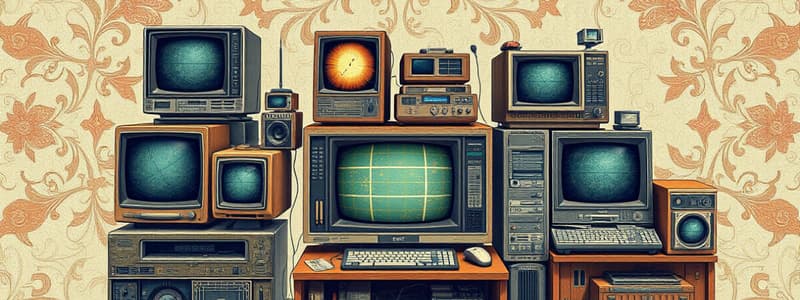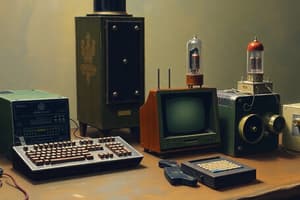Podcast
Questions and Answers
Which generation of computers used vacuum tubes?
Which generation of computers used vacuum tubes?
- Second Generation
- Fourth Generation
- First Generation (correct)
- Third Generation
Which of the following is a characteristic of the second generation of computers?
Which of the following is a characteristic of the second generation of computers?
- Vacuum tube based
- Artificial intelligence based
- Integrated circuit based
- Transistor based (correct)
What is a key feature of microprocessor-based computers?
What is a key feature of microprocessor-based computers?
- They are from the second generation
- They use transistors
- They are based on vacuum tubes
- They contain the CPU on an integrated circuit (correct)
What does CPU stand for?
What does CPU stand for?
The concept of zero was developed in 875 AD.
The concept of zero was developed in 875 AD.
Who is known as the father of modern computer?
Who is known as the father of modern computer?
The first mechanical calculator was invented by __________.
The first mechanical calculator was invented by __________.
Which device controls the flow of electrons in a vacuum?
Which device controls the flow of electrons in a vacuum?
Who invented the first working telephone?
Who invented the first working telephone?
Match the following inventions with their inventors:
Match the following inventions with their inventors:
Lady Ada Augusta Lovelace Byron is considered the first computer programmer.
Lady Ada Augusta Lovelace Byron is considered the first computer programmer.
Flashcards are hidden until you start studying
Study Notes
Generations of Computers
- First Generation: (1940s-1950s) relied on vacuum tubes for operation. Notable computers include ENIAC, UNIVAC, IBM 650, and IBM 701.
- Second Generation: (1950s-1960s) used transistors, which were smaller, faster, and more reliable than vacuum tubes. Key examples are IBM 1401, IBM 7090 and 7094, and UNIVAC 1107.
- Third Generation: (1960s-1970s) utilized integrated circuits (ICs) which contained many transistors on a single chip. Popular machines from this era include IBM 360, IBM 370, PDP-11, and UNIVAC 1108.
- Fourth Generation: (1970s-Present) saw the emergence of microprocessors, which integrated the entire CPU onto a single chip. This led to the creation of personal computers like the IBM PC, STAR 1000, APPLE II, and Apple Macintosh.
- Fifth Generation: (Present and Future) focuses on artificial intelligence (AI). Computers from this generation are used for various tasks including running desktops, laptops, tablets, and smartphones.
Key Computer Components and Technologies
- Vacuum Tube: An electronic device controlling electron flow in a vacuum.
- Transistor: An electronic component acting as an amplifier or a switch.
- Integrated Circuit (IC): A miniaturized electronic circuit printed on a chip, containing various elements like transistors, diodes, and resistors.
- Microprocessor: An electronic component that houses the CPU and other circuits on an integrated circuit.
- CPU (Central Processing Unit): The brain of a computer, where most processing and operations take place.
- Magnetic Drum: A cylinder coated with magnetic material, used to store data and programs.
- Magnetic Core: Uses arrays of small magnetized rings called cores to store information.
- Machine Language: A low-level language consisting of binary digits (ones and zeros) that can be understood by a computer.
- Memory: A device used to store data, information, and programs in a computer.
- Artificial Intelligence (AI): A field of computer science focusing on computer systems that can simulate and create intelligent behavior by thinking, learning, working, and reacting like humans.
Eras of Computer Development
- Premechanical Age: (3000 BC - 1450 AD)
- Mechanical Age: (1450 - 1840)
- Electromechanical Age: (1840 - 1940)
- Electronic Age: (1940 - Present)
Writing and Alphabets
- Petroglyphs: Signs or figures carved into rock.
- Ideographs: Symbols representing ideas and concepts.
- Cuneiform: The first true written language and information system.
- Sumerians: Utilized a stylus and wet clay for writing.
- Egyptians: Papyrus was used for writing (2600 BC).
- Chinese: Created paper from rags (100 AD).
- Books and Libraries:
- Mesopotamia: Religious leaders housed the earliest books.
- Egyptians: Kept scrolls.
- Greeks (600 BC): Sheets of papyrus were folded and bound into volumes.
First Numbering System
- Egyptians: Used vertical lines (|) for numbers 1-9, U or O for 10, coiled rope for 100, and lotus blossom for 1000.
- Hindus (100-200 AD): Developed the 9-digit numbering system.
- The concept of zero was introduced around 875 AD.
- Abacus: The first calculator invented in Babylonia and popularized in China.
Key Inventions and Pioneers
- Johann Gutenberg (1450): Invented the movable metal-type printing process.
- John Napier: Created logarithms (LOGS) simplifying multiplication and division.
- Arabian Lattice: Created a special multiplication chart on wooden rods.
- Wilhelm Schickard: Built the first mechanical calculator capable of six-digit calculations.
- William Oughtred: Developed the slide rule.
- Blaise Pascal: Invented the Pascaline, a mechanical calculator for addition and subtraction.
- Gottfried Leibniz: Developed the Stepped Reckoner, a mechanical calculator.
- Joseph-Marie Jacquard: Created the automatic loom controlled by punch cards.
- Charles Xavier Thomas de Colmar: Developed the Arithmometer, the first mass-produced calculator.
- Charles Babbage: The "Father of Modern Computer," who invented the Difference Engine and Analytical Engine.
- Lady Ada Augusta Lovelace Byron: The first computer programmer.
- Alessandro Volta: Invented the Voltaic Battery, the first electric battery.
- Samuel F.B. Morse: Developed the electromagnetic telegraph.
- Alexander Graham Bell: Invented the first working telephone.
- Guglielmo Marconi (Radio): Discovered that radio waves travel through space.
- George Boole: Created Boolean Algebra, a binary algebra.
- Pehr and Edward Scheutz: Completed the first printing difference engine.
Studying That Suits You
Use AI to generate personalized quizzes and flashcards to suit your learning preferences.




